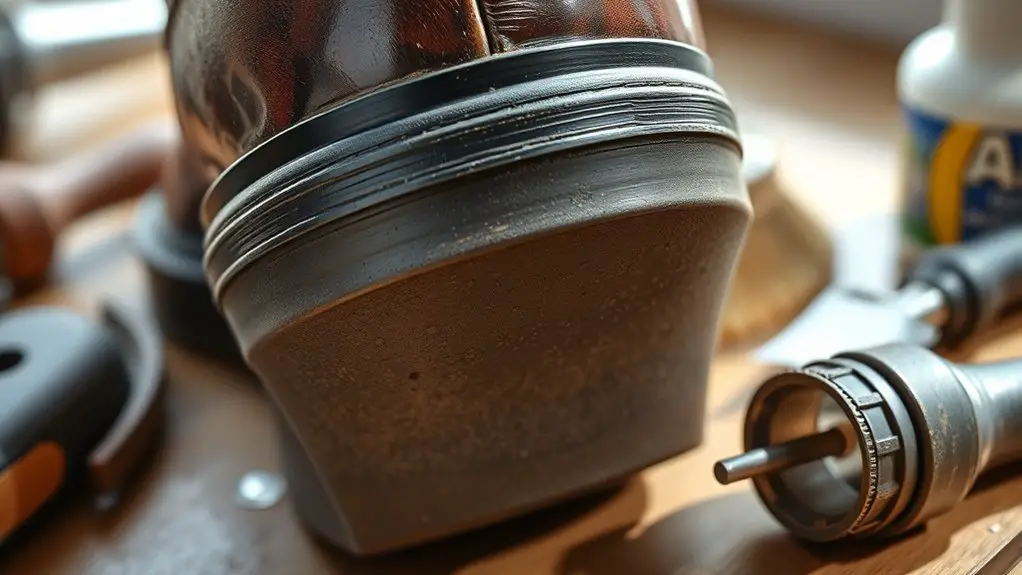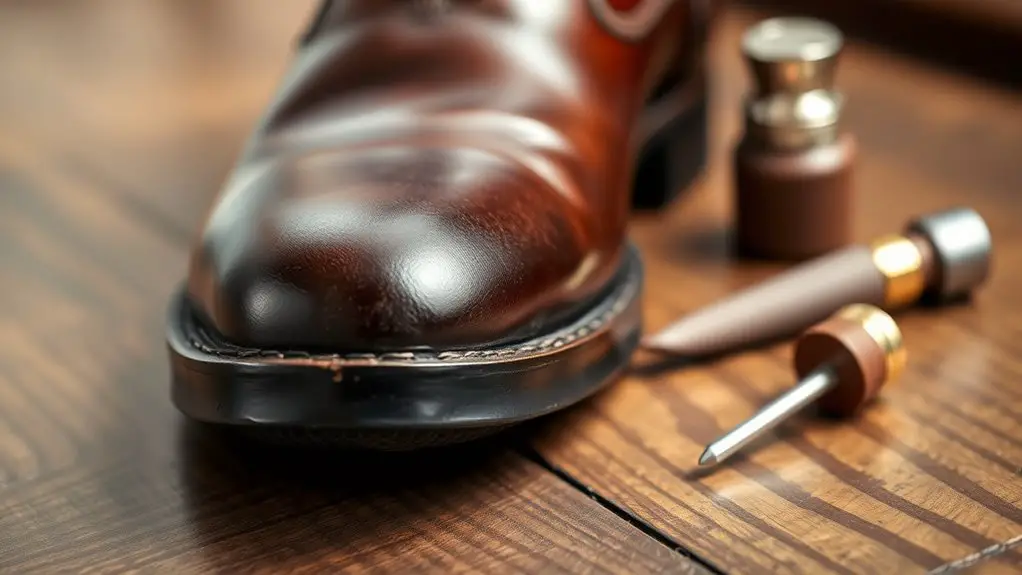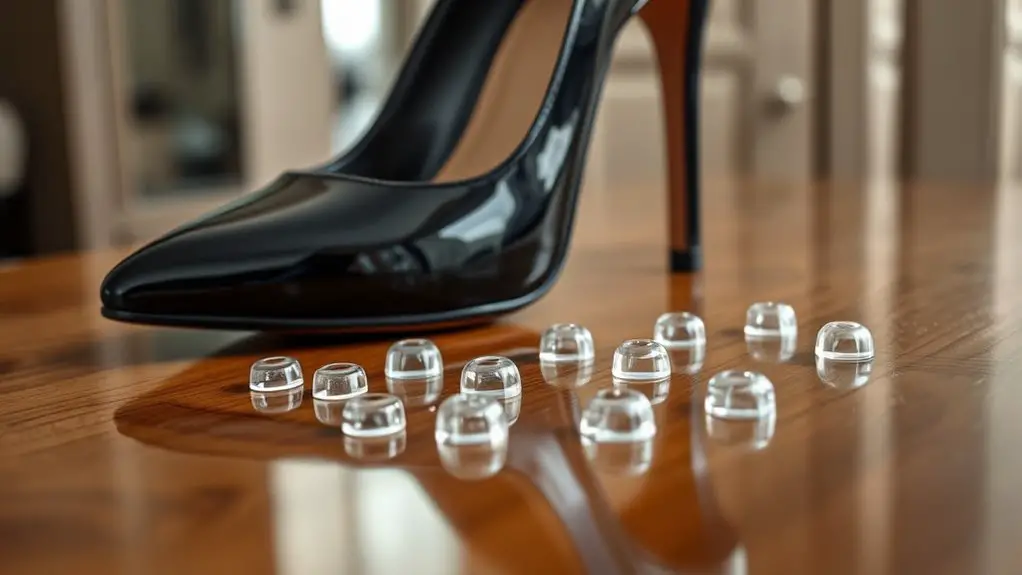To make heel rubber last longer, start by understanding its composition, which blends natural and synthetic materials for durability. Choose shoes tailored to your daily activities and rotate them regularly to prevent uneven wear. Invest in quality footwear and maintain proper cleaning habits by removing dirt weekly. Store your shoes correctly and consider using heel protectors for added longevity. Be mindful of walking surfaces, and you’ll discover more effective strategies to enhance your shoe’s lifespan.
Understand the Composition of Heel Rubber

Heel rubber, often overlooked, plays a crucial role in the durability of your footwear. Through composition analysis, you’ll find that heel rubber typically consists of natural and synthetic materials, each contributing to its overall performance. Natural rubber offers flexibility and resilience, while synthetic rubbers, like SBR or NR, enhance durability and resistance to wear. Understanding these components helps you appreciate the science behind rubber durability.
The blend of these materials influences the heel’s ability to withstand pressure and friction during use. For instance, a higher percentage of synthetic rubber can provide better abrasion resistance, essential for high-traffic environments. Additionally, additives like carbon black improve UV resistance, extending the life of your heel rubber. By knowing what’s in your heel rubber, you can make informed choices about maintenance and care, ensuring your footwear stays functional and stylish for longer.
Choose the Right Shoes for Your Lifestyle
When selecting shoes, it’s essential to contemplate your lifestyle and the specific demands it places on your footwear. Lifestyle considerations such as your daily activities, work environment, and leisure pursuits greatly influence shoe functionality. For instance, if you’re frequently on your feet in a professional setting, opt for shoes with supportive arch structures and durable heel rubber to withstand prolonged wear. Conversely, if your lifestyle involves casual outings, lightweight materials and flexible soles may be more appropriate.
Also, consider the terrain you navigate; running shoes with cushioned heels are ideal for pavement, while hiking shoes require reinforced rubber for rugged paths. Investing in shoes that align with your lifestyle not only enhances comfort but also prolongs the life of the heel rubber. Selecting the right shoes tailored to your daily movements will ultimately reduce wear and tear, ensuring they last longer and perform better.
Rotate Your Footwear Regularly

Rotating your footwear is essential for extending the life of heel rubber and maintaining foot health. By selecting a diverse range of shoe styles, you can distribute wear more evenly and reduce stress on specific areas. Aim to change your shoes every few days to keep them in ideal condition and enhance their durability.
Importance of Footwear Rotation
While you might not realize it, regularly rotating your footwear can greatly extend the life of your heel rubber. By switching between different pairs, you allow each pair to rest and recover from the stresses of daily use. This not only prevents uneven wear on the heel rubber but also promotes better cushioning and support.
Additionally, footwear rotation offers significant injury prevention benefits. Different shoes provide varying levels of support and stability, reducing the risk of repetitive strain injuries. When you alternate shoes, you engage different muscle groups, enhancing your overall foot health. So, make it a habit to rotate your footwear; it’s a simple yet effective strategy to maximize the longevity of your shoes and maintain peak foot function.
Selecting Diverse Shoe Styles
To truly maximize the longevity of your heel rubber, selecting a diverse range of shoe styles is vital. This approach not only enhances shoe versatility but also reduces wear on specific pairs. By rotating between heels, flats, sneakers, and boots, you allow each type of footwear to rest and recover its shape and cushioning, minimizing the stress on the heel rubber. Furthermore, incorporating various style combinations can keep your wardrobe fresh and functional. For instance, pairing casual sneakers with formal attire can create unexpected yet stylish looks, encouraging you to wear different shoes regularly. Ultimately, embracing a variety of shoe styles guarantees that your heel rubber lasts longer while maintaining your fashion-forward image.
Timing for Rotation Changes
Effective timing for rotating your footwear can greatly extend the life of your heel rubber. By adhering to specific timing intervals and adjusting your rotation frequency, you can minimize wear and tear on your shoes. Here are some key tips to contemplate:
- Rotate every 2-3 days to allow rubber to recover.
- Use at least three pairs to distribute wear evenly.
- Monitor your shoe condition weekly for signs of wear.
- Contemplate seasonal changes, rotating shoes based on weather.
- Keep a rotation schedule to maintain consistency.
Invest in Quality Shoes

Investing in quality shoes is essential for enhancing the longevity of heel rubber. Look for durable materials like high-grade leather or synthetic options designed to withstand wear, as these can greatly reduce the frequency of replacements. Additionally, prioritizing comfort and fit guarantees that your shoes support your feet properly, minimizing undue stress on the heel area.
Choose Durable Materials
Choosing durable materials is essential when selecting quality shoes, as they directly impact the longevity of the heel rubber. Different material types and durability factors can greatly influence how well your shoes withstand wear and tear.
Consider these key materials:
- Genuine Leather: Offers natural resilience and flexibility.
- Synthetic Leather: Often more resistant to moisture and easier to clean.
- Rubber Outsoles: Provides excellent grip and shock absorption.
- Nylon Mesh: Lightweight and breathable, enhancing overall shoe durability.
- High-Quality Foam: Supports comfort while maintaining structure.
Prioritize Comfort and Fit
While many people focus solely on aesthetics when selecting shoes, prioritizing comfort and fit is essential for both foot health and the longevity of heel rubber. Quality shoes often incorporate advanced comfort features, such as cushioned insoles and arch support, which can greatly reduce foot fatigue. When evaluating fit, verify there’s enough room in the toe box and that the heel secures snugly without slipping. A proper fit evaluation can prevent blisters and other foot issues that may lead to uneven wear on the heel rubber. Remember, investing in well-fitting, comfortable shoes not only enhances your walking experience but also prolongs the life of your footwear, making it a smart choice for both your feet and your budget.
Maintain Proper Cleaning Habits
Keeping your heel rubber in top shape starts with proper cleaning habits. Regular maintenance not only prolongs the lifespan of the rubber but also enhances its performance. You should establish a cleaning frequency that suits your lifestyle, ideally at least once a week. Use appropriate cleaning products designed for rubber materials to avoid damage.
- Use a soft brush to remove dirt and grime.
- Avoid harsh chemicals that can degrade rubber.
- Rinse with lukewarm water after cleaning.
- Dry thoroughly to prevent mold or mildew.
- Inspect for wear and tear during cleaning.
Store Shoes Properly
Proper cleaning habits set the foundation for maintaining your heel rubber, but how you store your shoes can greatly impact their longevity as well. To guarantee ideal shoe storage, always keep your footwear in a cool, dry place. Excessive heat or humidity can warp the materials and weaken the heel rubber. Consider investing in a climate-controlled environment, especially if you live in areas with extreme weather conditions.
Avoid stacking shoes haphazardly, as this can deform their shape and affect the heel rubber’s integrity. Use shoe boxes or organizers to maintain structure and prevent unnecessary pressure. For leather or delicate materials, consider adding silica gel packs to absorb moisture and protect the shoes from dampness.
Regularly inspect your shoe storage area to guarantee it’s free of pests and dirt, as these can also compromise the quality of your heel rubber.
Use Heel Protectors and Caps
Using heel protectors and caps can greatly extend the lifespan of your heel rubber, as these accessories provide an extra layer of defense against wear and tear. By investing in quality heel protectors, you’ll considerably reduce the friction and pressure your shoes experience during daily activities. Here are some cap options to take into account:
Using heel protectors can significantly enhance shoe longevity by minimizing wear and tear during everyday use.
- Rubber Caps: Offer excellent grip and durability.
- Gel Caps: Provide cushioning and shock absorption.
- Leather Caps: Add a touch of elegance while protecting against scuffs.
- Plastic Caps: Lightweight and affordable, ideal for casual wear.
- Custom Caps: Tailored to fit specific shoe designs for peak protection.
When selecting heel protectors and caps, verify they fit snugly to prevent slipping. Regularly check for damage and replace them as needed to maintain your shoe’s integrity. By using these accessories, you’ll not only enhance comfort but also prolong the life of your heel rubber.
Be Mindful of Walking Surfaces
Although it might seem minor, the surfaces you walk on can greatly impact the longevity of your heel rubber. Different materials, like asphalt, concrete, and tile, exert varying levels of wear on your heels. Being aware of these surfaces is essential; harder surfaces typically cause more abrasion than softer ones.
To prolong the life of your heel rubber, adjust your walking techniques accordingly. For instance, on rough surfaces, try to minimize your heel striking the ground by adopting a more balanced gait. This reduces the impact on the rubber and helps maintain its integrity.
When traversing uneven or poorly maintained surfaces, take extra caution to avoid excessive dragging or scuffing. Surface awareness can make a significant difference; by consciously choosing your paths and adjusting your movement, you can extend the lifespan of your heel rubber, ensuring your footwear remains comfortable and functional for longer.
Schedule Regular Professional Maintenance
To maintain the integrity of your heel rubber, scheduling regular professional maintenance is a wise investment. By doing so, you not only extend the life of your footwear but also enhance your comfort and safety. Professional inspections can identify potential issues before they become significant problems, allowing for timely repairs.
Here are some key benefits of scheduling maintenance:
- Early detection of wear and tear: Catch minor damages before they escalate.
- Optimal performance: Guarantee your heel rubber functions as intended.
- Customized care: Experts provide tailored solutions based on your shoe type and usage.
- Increased comfort: Properly maintained heels support better foot alignment.
- Cost-effectiveness: Regular maintenance can save you money in the long run by preventing replacement.
Incorporate these practices into your routine, and you’ll enjoy the longevity of your heel rubber like never before.
Frequently Asked Questions
How Can I Tell if My Heel Rubber Is Worn Out?
To tell if your heel rubber’s worn out, check for uneven heel wear or visible cracks. If the rubber’s considerably degraded, it’s time for a heel replacement to maintain ideal support and comfort in your footwear.
What Types of Heel Protectors Are Best for Different Shoe Styles?
For ideal shoe style compatibility, choose heel protectors made from durable rubber or silicone. Rubber’s shock absorption suits heels, while silicone’s flexibility works well for flats. Verify the material matches your shoe’s design for effective protection.
Can I Repair Heel Rubber Myself or Should I Seek a Professional?
You can tackle a DIY repair if you’re handy, but for lasting results and technical expertise, seeking professional services might be better. Weigh your skills against the shoe’s value to make the best choice.
Does Weather Affect the Lifespan of Heel Rubber?
Extreme temperatures can reduce rubber durability by up to 50%. When there’s considerable weather impact, such as heat or moisture, it can lead to cracks and wear, affecting the lifespan of your heel rubber considerably.
How Often Should I Clean My Shoes to Extend Heel Rubber Life?
To extend heel rubber life, you should clean your shoes bi-weekly. Regular maintenance, including removing dirt and debris, helps prevent wear. Following these shoe maintenance tips can greatly improve the longevity of your footwear.



